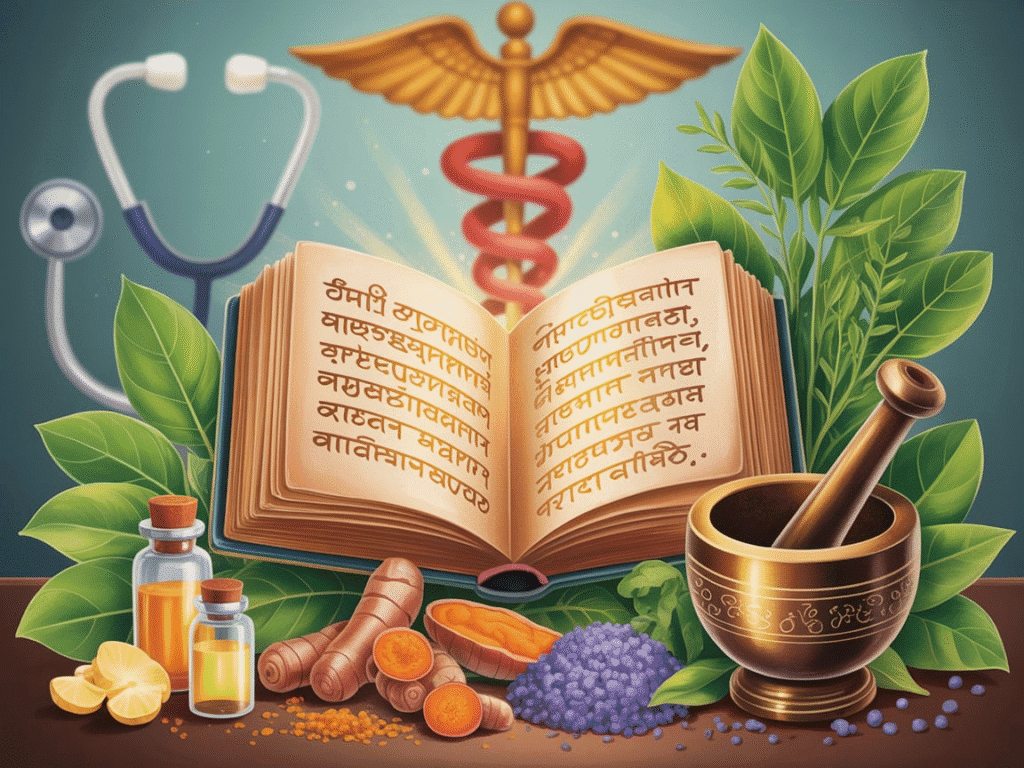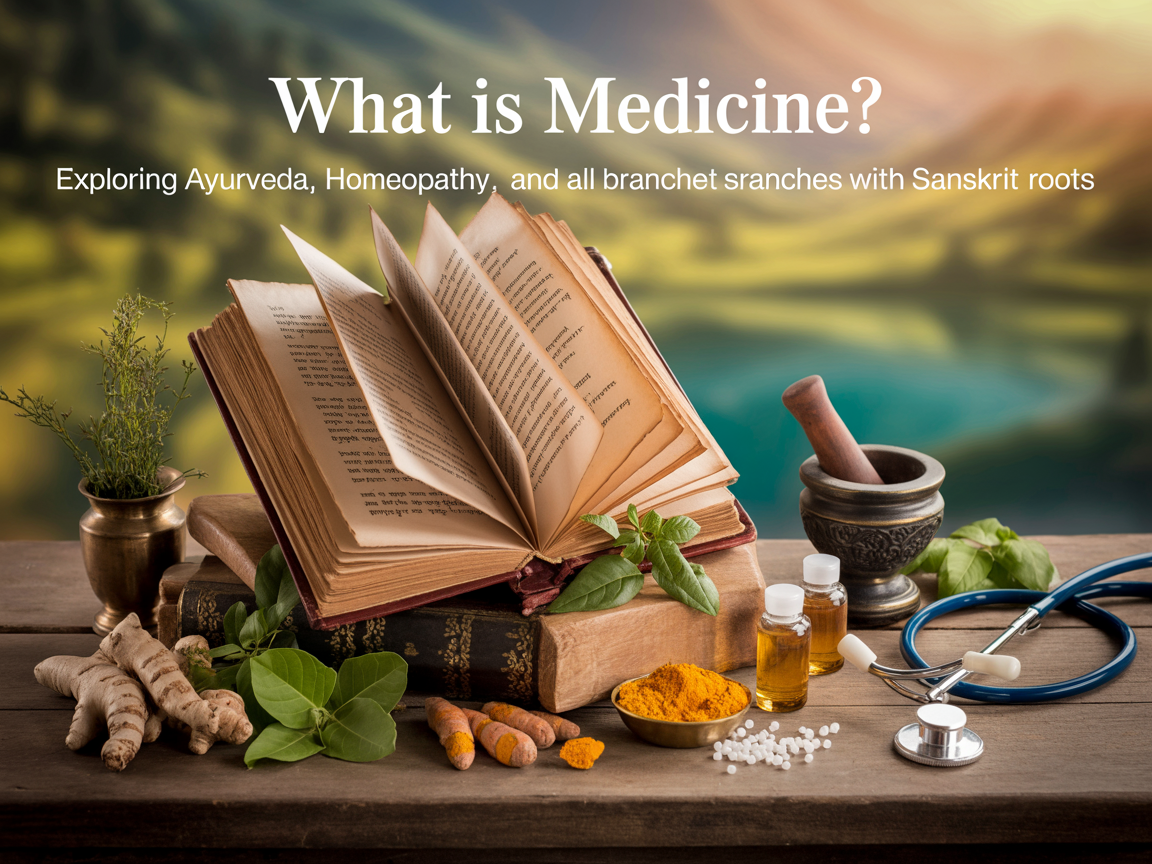Medicine is the art and science of healing, a vast field dedicated to preventing, diagnosing, and treating illnesses to improve human health. It’s a bridge between science and compassion, blending cutting-edge research with age-old wisdom to restore balance in the body and mind. From ancient herbal remedies to modern surgical techniques, medicine has evolved over centuries, adapting to cultural, scientific, and societal changes. In this blog post, we’ll dive into the world of medicine, exploring its various branches, including traditional systems like Ayurveda and Homeopathy, and their connections to ancient wisdom, such as Sanskrit texts. Whether you’re curious about natural remedies or intrigued by modern pharmacology, this guide will break it all down in simple terms.

What is Medicine? A Simple Definition
At its core, medicine is about understanding the human body, identifying what’s wrong when we’re unwell, and finding ways to fix it. It’s not just about pills or surgeries; it’s a holistic approach that includes physical, mental, and emotional well-being. Medicine encompasses a range of practices, from ancient traditions passed down through generations to cutting-edge innovations like gene therapy. Each system, whether it’s Ayurveda’s herbal concoctions or Allopathy’s precise diagnostics, aims to restore harmony within the body.
Major Branches of Medicine
Medicine is a diverse field with multiple branches, each offering unique perspectives on health and healing. Below, we explore the primary systems, including traditional, alternative, and modern approaches, to give you a clear picture of their roles and philosophies.
Allopathy: The Backbone of Modern Medicine
Allopathy, often called Western or conventional medicine, is the most widely practiced medical system globally. It relies on scientific evidence, rigorous testing, and standardized treatments like medications, surgeries, and therapies. Allopathy focuses on diagnosing diseases through symptoms and using targeted interventions, such as antibiotics for infections or chemotherapy for cancer. It’s driven by advancements in technology, like MRI scans and robotic surgeries, making it highly effective for acute conditions and emergencies.
While Allopathy excels in treating specific ailments, it sometimes overlooks holistic aspects like lifestyle or emotional health. However, its precision and evidence-based approach make it a cornerstone of modern healthcare.
Ayurveda: The Science of Life
Ayurveda, meaning “the science of life” in Sanskrit, is an ancient Indian medical system dating back over 5,000 years. Rooted in the belief that health is a balance of body, mind, and spirit, Ayurveda uses natural remedies, diet, and lifestyle changes to promote wellness. It’s based on the concept of three doshas—Vata (air), Pitta (fire), and Kapha (earth)—which govern bodily functions. Imbalances in these doshas lead to illness, and treatments aim to restore harmony.
Ayurveda’s principles are documented in ancient Sanskrit texts like the Charaka Samhita and Sushruta Samhita. The Charaka Samhita, attributed to the sage Charaka, is a comprehensive guide to internal medicine, detailing herbal treatments, diet, and diagnostics. The Sushruta Samhita, credited to Sushruta, focuses on surgical techniques and is considered one of the earliest texts on surgery. A famous shloka from the Charaka Samhita encapsulates Ayurveda’s philosophy:
“Swasthasya swasthya rakshanam, aturasya vikar prashamanam cha.”
स्वस्थस्य स्वास्थ्यरक्षणं आतुरस्य विकारप्रशमनं च।
(Translation: The goal is to protect the health of the healthy and alleviate the diseases of the sick.)
Explaination: “Health is defined as a state where the doshas (Vata, Pitta, Kapha), digestive fire (agni), tissues (dhatus), and excretory functions (malakriya) are balanced, and the soul, senses, and mind are in a state of contentment.”
Ayurveda uses herbs like turmeric, ashwagandha, and tulsi, along with practices like yoga and meditation, to treat conditions ranging from digestive issues to stress. Its personalized approach makes it popular for chronic conditions and preventive care.
Homeopathy: Healing Through Like Cures Like
Homeopathy, developed in the late 18th century by Samuel Hahnemann, is based on the principle of “like cures like.” It uses highly diluted substances that, in larger doses, would cause symptoms similar to the illness being treated. For example, a remedy for allergies might use a diluted form of an allergen. Homeopathy aims to stimulate the body’s natural healing processes, focusing on the individual rather than the disease alone.
Homeopathic remedies are prepared through a process of serial dilution and succussion (vigorous shaking), believed to enhance their potency. While scientific evidence on its efficacy is mixed, many people swear by Homeopathy for conditions like migraines, anxiety, and skin disorders. Its gentle, non-invasive nature makes it appealing for those seeking alternative treatments.
Naturopathy: Nature’s Healing Power
Naturopathy emphasizes the body’s ability to heal itself using natural methods like nutrition, exercise, and herbal medicine. It combines elements of traditional practices with modern science, focusing on prevention and lifestyle changes. Naturopaths often use therapies like acupuncture, hydrotherapy, and dietary counseling to address the root causes of illness rather than just symptoms.
This system is ideal for those looking to boost overall wellness or manage chronic conditions like fatigue or digestive problems. Naturopathy’s holistic approach aligns closely with Ayurveda, though it lacks the deep cultural and textual roots found in Sanskrit-based systems.
Traditional Chinese Medicine (TCM): Balancing Yin and Yang
Traditional Chinese Medicine, practiced for over 2,000 years, is built on the concept of balancing yin and yang—opposing forces that govern health. TCM uses acupuncture, herbal remedies, cupping, and tai chi to restore energy flow, or qi, through the body’s meridians. Like Ayurveda, TCM emphasizes prevention and holistic care, treating the body as an interconnected system.
TCM’s herbal formulas and acupuncture are widely used for pain management, fertility issues, and stress relief. While it shares similarities with Ayurveda, its philosophical roots are tied to Chinese cosmology rather than Sanskrit texts.
Unani: The Greco-Arabic Tradition
Unani, originating from ancient Greek medicine and refined in the Islamic world, focuses on balancing the body’s four humors: blood, phlegm, yellow bile, and black bile. Practitioners use herbal medicines, diet, and lifestyle adjustments to treat ailments. Unani is widely practiced in South Asia and the Middle East, particularly for chronic conditions like arthritis and respiratory issues.
Though Unani shares some principles with Ayurveda, such as the use of herbs and diet, it’s distinct in its Greco-Arabic origins and lacks direct ties to Sanskrit literature.
Siddha: The South Indian Healing Art
Siddha, another ancient Indian system, is closely related to Ayurveda but has its own unique practices, primarily in South India. It emphasizes the balance of three humors—Vatham, Pitham, and Kapham—and uses herbs, minerals, and yoga to treat diseases. Siddha texts, written in Tamil rather than Sanskrit, include works like Agastya Samhita. This system is particularly known for its use of mineral-based medicines and spiritual practices to enhance longevity.
Other Medical Systems
- Osteopathy: Focuses on the musculoskeletal system, using manual techniques like stretching and massage to improve health.
- Chiropractic: Emphasizes spinal alignment to treat pain and improve overall health.
- Energy Medicine: Includes practices like Reiki, which aim to balance the body’s energy fields for healing.
- Functional Medicine: A modern approach that addresses the root causes of disease through personalized diet and lifestyle plans.
Each system offers unique tools and philosophies, catering to different needs and preferences. Some, like Ayurveda, are deeply rooted in cultural traditions, while others, like Functional Medicine, are relatively new.
The Role of Sanskrit in Medicine
Sanskrit, the ancient language of India, is a treasure trove of medical knowledge, particularly for Ayurveda and Siddha. Texts like the Charaka Samhita, Sushruta Samhita, and Ashtanga Hridaya are written in Sanskrit and form the backbone of Ayurvedic practice. These texts detail everything from anatomy and diagnostics to herbal formulations and surgical procedures. For example, the Sushruta Samhita describes over 300 surgical procedures, including cataract surgery, using precise Sanskrit terminology.
Sanskrit’s influence extends beyond Ayurveda. Its precise grammar and vocabulary allowed ancient scholars to document complex medical concepts with clarity. A shloka from the Ashtanga Hridaya, another key Ayurvedic text, highlights the importance of balance:
“Samadosha samagnischa samadhatu malakriya, prasanna atma indriya manaha swastha ityabhidhiyate.”
(Translation: Health is a state where doshas, digestion, tissues, and excretions are balanced, and the soul, senses, and mind are content.)
These texts remain relevant today, guiding Ayurvedic practitioners in diagnosing and treating ailments using time-tested methods.
How These Systems Work Together
While each medical system has its strengths, many people combine them for a holistic approach. For example, someone might use Allopathy for acute infections, Ayurveda for stress management, and Homeopathy for chronic pain. Integrative medicine, a growing field, blends conventional and alternative therapies to address the whole person—body, mind, and spirit.
For instance, a patient with diabetes might take insulin (Allopathy), follow an Ayurvedic diet to balance blood sugar, and practice acupuncture (TCM) for stress relief. This synergy allows for personalized care, leveraging the best of each system.
Benefits and Challenges of Different Medical Systems
Benefits
- Allopathy: Quick, effective for emergencies, backed by extensive research.
- Ayurveda: Holistic, preventive, excellent for chronic conditions.
- Homeopathy: Gentle, individualized, minimal side effects.
- Naturopathy: Focuses on lifestyle, promotes long-term health.
- TCM: Effective for pain and stress, widely accessible.
Challenges
- Allopathy: May overlook lifestyle factors, potential for overmedication.
- Ayurveda: Requires time and commitment, limited scientific validation.
- Homeopathy: Controversial efficacy, slow results for some conditions.
- Naturopathy: May lack standardization, not ideal for acute issues.
- TCM: Acupuncture requires skilled practitioners, cultural barriers for some.
Choosing the Right System for You
Selecting a medical system depends on your health needs, beliefs, and lifestyle. For acute conditions like a broken bone, Allopathy is often the best choice. For chronic issues like fatigue or digestive problems, Ayurveda or Naturopathy might offer long-term relief. Homeopathy and TCM are great for those seeking non-invasive options. Always consult a qualified practitioner and consider integrating multiple systems for optimal results.
The Future of Medicine
The future of medicine lies in integration and innovation. Advances in genomics, artificial intelligence, and personalized medicine are transforming Allopathy, while traditional systems like Ayurveda and TCM are gaining global recognition. Research is also bridging the gap between ancient wisdom and modern science, validating practices like meditation and herbal remedies.
As we move forward, the focus is shifting toward prevention, holistic care, and patient empowerment. Whether it’s through a Sanskrit shloka from the Charaka Samhita or a cutting-edge diagnostic tool, the goal remains the same: to help people live healthier, happier lives.
Conclusion
Medicine is a vast and beautiful tapestry, weaving together ancient traditions and modern innovations. From Ayurveda’s Sanskrit-rooted wisdom to Homeopathy’s gentle remedies, each system offers unique insights into healing. By understanding these branches, you can make informed choices about your health, blending the best of science and tradition. Whether you’re drawn to the holistic balance of Ayurveda or the precision of Allopathy, the world of medicine has something for everyone. Explore, learn, and find what resonates with you on your journey to wellness.

